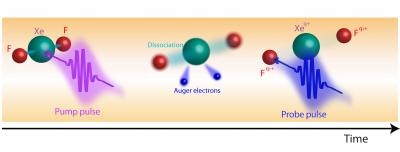Jun 17 2016
With the onset of the summer blockbuster season, many fast-paced action films are expected to be released. A team of researchers have released a new kind of movie that portrays atomic-level explosions and provides scientists with new insights about X-ray-molecule interaction.
 A team led by researchers from the Argonne National Laboratory used the high-intensity, quick-burst X-rays provided by the Linac Coherent Light Source (LCLS) at SLAC National Accelerator Laboratory to look at how the atoms in a molecule change when the molecule is bombarded with X-rays. This schematic shows the dissociation of a xenon difluoride molecule during the X-ray pump/X-ray probe process. (CREDIT: Antonio Picon)
A team led by researchers from the Argonne National Laboratory used the high-intensity, quick-burst X-rays provided by the Linac Coherent Light Source (LCLS) at SLAC National Accelerator Laboratory to look at how the atoms in a molecule change when the molecule is bombarded with X-rays. This schematic shows the dissociation of a xenon difluoride molecule during the X-ray pump/X-ray probe process. (CREDIT: Antonio Picon)
Quick-burst, high-intensity X-rays from the Linac Coherent Light Source (LCLS) at the SLAC National Accelerator Laboratory were used by the team. Researchers from the U.S. Department of Energy's (DOE's) Argonne National Laboratory led the research. X-rays from the LCLS source were used to observe the changes happening to atoms in a molecule when it is exposed to X-rays.
The LCLS gives us a unique perspective on molecular dynamics because of the extremely brief X-ray pulses that we can use. We're able to see how charge and energy can flow through a system with amazing precision. The new X-ray pump/X-ray probe technique is so powerful because it allows us to shake the molecule at one point, and look at how it changes at a second point.
Antonio Picon, X-Ray Scientist, Argonne National Laboratory
A specifically targeted inner-shell electron present in a xenon atom that is bonded to two fluorine atoms was excited by the researchers using a new method known as X-ray pump/X-ray probe. After the excitation of the electron out of its shell, the unbalanced positive charge in the remaining molecule makes the molecule to instantaneously dissociate. This process of dissociation is known as "Coulomb explosion."
The new X-ray pump/X-ray probe technique is so powerful because it allows us to shake the molecule at one point, and look at how it changes at a second point.
Christoph Bostedt, X-Ray Scientist, Argonne National Laboratory
The xenon difluoride molecule is only the preliminary step for this method. Going forward, X-ray pump/X-ray probe method might find potential in a vast range of applications like, tracking the energy flow in molecules, or the ultrafast structural changes that happen in light-sensitive molecules. The knowledge of intramolecular energy flow allows researchers to develop new materials in a better manner for harnessing the solar energy, such as photocatalysts and photovoltaics.
This new method could also be helpful to handle the challenges related to the protein structure determination. Although in pharmaceutical studies, X-rays are mostly used to determine the structures of proteins, they might damage parts of the protein as well.
"This technique lets you see how neighboring atoms are affected when certain regions interact with X-rays," said Stephen Southworth, an Argonne senior X-ray scientist.
With the help of an X-ray pump, one of the innermost electrons of a molecule was excited. This, in turn, allowed the researchers to target one of the electrons that is characteristic of and most central to the molecule.
"This technique gives us the ability to take a series of quick snapshots to see what happens when we change a fundamental part of a molecule, and what we learn from it can inform how we approach the interactions between light and molecules in the future," said Picon.
The DOE Office of Science funded this research project. Besides SLAC, Argonne, and Kansas State University also participated in this research.
For these kinds of studies, you really need a team that combines world leaders in X-ray sources, particle detection and sample manipulation.
Stephen Southworth, Senior X-Ray Scientist, Argonne National Laboratory
An article based on the research work, "Hetero-site-specific X-ray pump-probe spectroscopy for femtosecond intramolecular dynamics," was published in the May 23 online edition of the Nature Communications journal.
Source: http://www.anl.gov/